The past decade has seen the explosive growth of rechargeable batteries. They are not only used in low-power portable electronic devices such as smart phones, tablets, laptops; but they are also used to power high-power products such as electric vehicles. Now, the fact that vehicles on the road running on electricity is no longer a strange thing for everyone. However, to make sure these vehicles operate safely under all conditions, specialized testing tools are required. To address these emerging design and test issues, Keysight has created and introduced this e-mobility brochure with an overview of the design and test solutions and services that Keysight offers in this ecosystem.
Test Solutions for Electric Vehicles and Power
To address these emerging design and test issues, Keysight has created and introduced innovative approaches to help developers and manufacturers accelerate their programs. This e-mobility brochure will provide you with an overview of the design and test solutions and services that Keysight offers in this ecosystem:
Electric powertrain testing: Ensure energy efficiency at the power semiconductor level, through inverter and DC-to-DC converter testing for onboard systems, as well as cell characterization and power efficiency tests for battery modules and packs, while addressing safety, time, and cost concerns.
Charging technology and infrastructure testing: Test the EV and Electric Vehicle Supply Equipment (EVSE) charging interfaces in the field or laboratory, from mobile use to comprehensive applications
Energy ecosystem testing: Use leading-edge emulation technology and software, spanning solar cell testing to PV inverter efficiency testing, to help meet stringent industry standards for safety and performance.
Electric Powertrain Testing
HEVs and EVs have multiple architectural variations
For the strong (or parallel) hybrid and the pure EV (no engine), a high-voltage (HV) bus supplied by a large battery drives the electric powertrain (Figure 2).
Power levels of the inverter and motor/generator range from ~ 60 kW to more than 180 kW. Along with the large lithium-ion (Li-ion) battery, development of these architectures requires a significant investment.
Most of the components are bidirectional, allowing power to go from the battery to the inverter, which turns the motor and moves the vehicle (traction drive). When decelerating, the momentum of the vehicle turns the generator, driving power back through the inverter and charging the battery (regenerative braking). Each step of this powertrain requires thorough testing to maximize energy efficiency for the HEV/EV.

In the mild hybrid (MH), the motor/generator, inverter, and battery are also bidirectional. They are not large enough to drive the vehicle by themselves (as in the HEV or EV). Instead, they supplement the engine power during acceleration and recharge the battery during deceleration.
The voltage level for MHs is typically 48 V, keeping the bus structure under the 60 V safety rating for HEVs. That provides four times the potential power of the 12 V bus with the same current rating (Figure 3).
Each component and step of these powertrain systems requires full testing to maximize energy efficiency in the conversion process.
The design and manufacturing phases must account for cohesive functionality of each component and subsystem, as well as safety considerations.
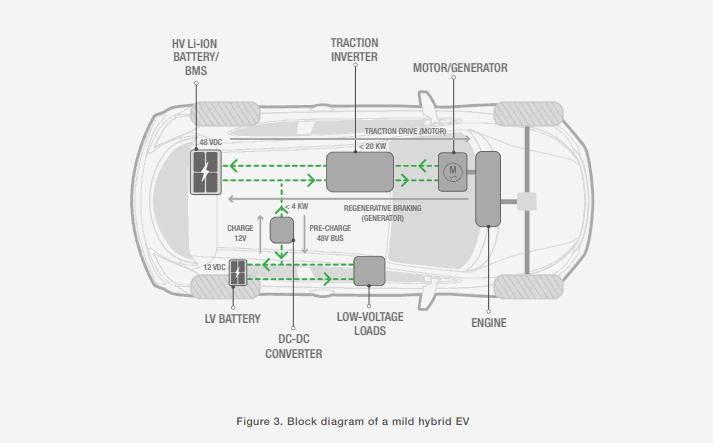
Inverter test
Inverters are essential components for numerous applications because they convert electrical voltage bidirectionally. Traction inverters convert DC voltage from a battery to AC voltage for an electric machine. This functionality makes inverters an important component in electromobility, as well as numerous industrial applications. Quality, durability, and safety requirements are demanding in the automotive sector. All components are subject to stringent testing throughout development and production. The earlier tests can be performed during the development phase, the more efficient the next steps are. Comprehensive test scenarios and independent component testing can reduce development expenses and speed innovation (Figure 4).
To emulate the inverter environment, replace the battery with a Scienlab Dynamic DC Emulator from Keysight. Replace the electric machine with a Scienlab Machine Emulator.
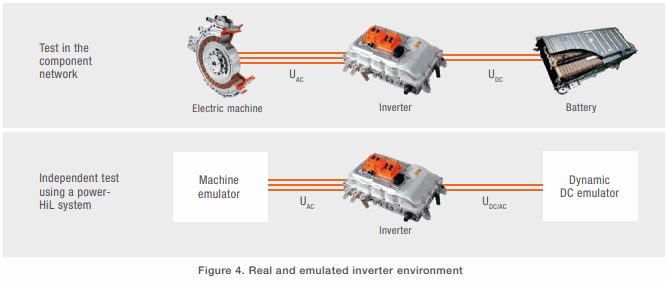
Scienlab Machine Emulators
For thorough testing of inverters, it is necessary to extensively emulate the electric machine. The Scienlab Machine Emulator from Keysight provides the facility for stressing the inverter using predefined load cycles in conjunction with the Scienlab Dynamic DC Emulator. Refer to “Supporting E-Mobility Test Technologies” for details about the Dynamic DC Emulator.
A variety of machines (e.g., PMSM, ASM, and induction machines) can be realistically emulated. That is possible in both motor and generator mode (fourquadrant mode). The emulation of the electric machine also encompasses all necessary sensors.
In addition, the open interface architecture enables easy connection of the Machine Emulator to an existing automation unit. The Machine Emulator is available for high-voltage, as well as 48 V applications.
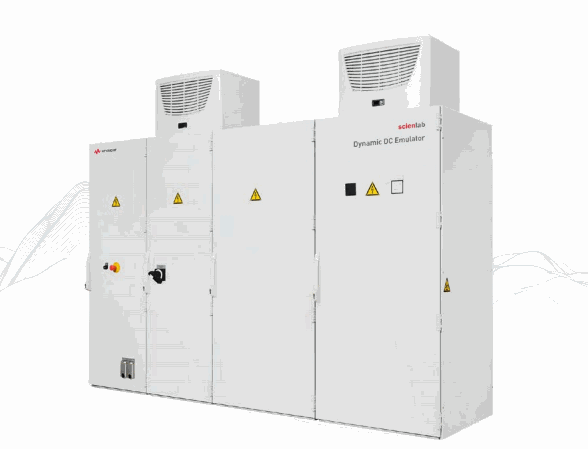
Cell and battery test
E-mobility has escalated the need for better cells and batteries with a common goal — improved performance, range, and cost. These devices must be high quality and meet the demands for power, energy density, safety, and durability. Marketplace survival requires cost optimization. For these reasons, comprehensive tests must be carried out to ensure successful design and production (Figure 5).
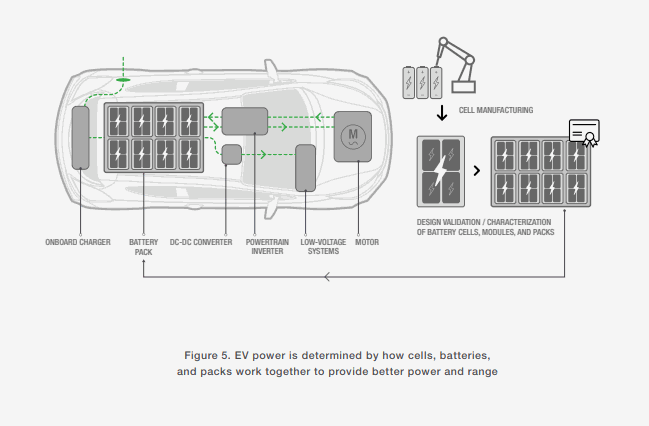
Cell self-discharge analysis
32-channel BT2152B Self-Discharge Analyzer
The Keysight BT2152B Self-Discharge Analyzer directly measures self-discharge current on large numbers of Li-ion cells. Using a potentiostatic measurement technique, it reduces the time required to discern good versus bad cell self discharge performance from days or weeks to minutes or hours. For cell manufacturers, this provides dramatic reductions in work-in-process inventory, working capital costs, and facility costs. For cell designers and evaluators, this provides faster cell analysis, which drives shorter design cycles and faster time-to-market (Figure 6). The BT2152B, along with the complementary BT2155A software, enables the following key features:
• Up to 32 channels of self-discharge current measurement available in four-channel increments
• Current measurement accuracy: ± (0.33% + 1 μA)
• Voltage measurement accuracy: ± (0.05% + 1 mV)
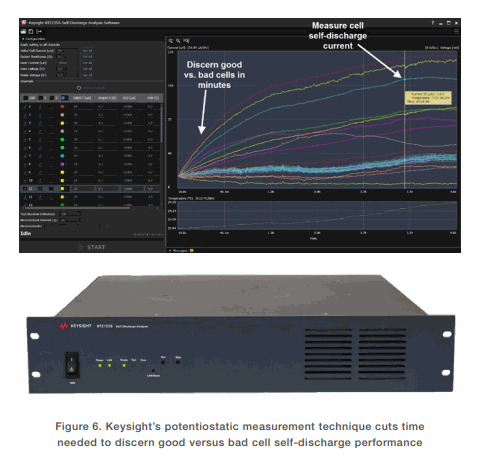
Cell characterization for R&D
Single-Channel BT2191A Self-Discharge Measurement System
Using a new potentiostatic measurement method, Keysight’s BT2191A Self-Discharge Measurement System for R&D (Figure 7) slashes the time needed for measuring self-discharge of Li-ion cells. For cylindrical 18650 or 21700 cells and other smaller cells, you can quickly measure stable self-discharge current in 30 minutes to two hours. For larger-capacity pouch cells (e.g., 10–60 Ah), it can take one to four hours versus days or weeks using the old method of measuring the change in open-circuit voltage of the cell over time. Key benefits enabled by the BT2191A, with the complementary BT2192A software, include:
- Faster measurement of self-discharge current
- Quick analysis of self-discharge current during cell design and evaluation
- Reduced design cycle time and achieving faster time to market
[%end-text-img-same-line%]After mechanical production of a Li-ion cell, it must be formed by controlled charging and discharging. Keysight offers modular cell formation systems that allow flexible configurations for forming small numbers of cells in R&D or large numbers in high-volume manufacturing.
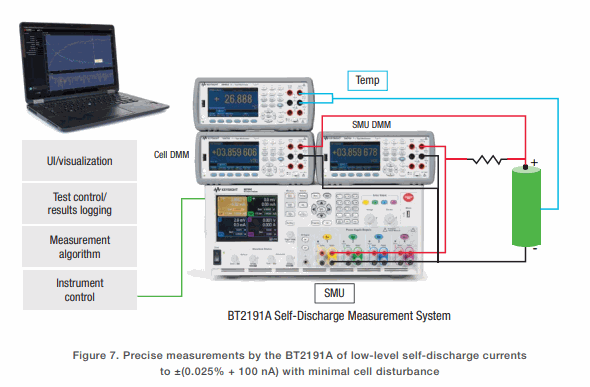
Cell charge-discharge platform
Keysight BT2200 Charge-Discharge Platform
The Keysight BT2200 Charge-Discharge Platform is cost-effective and easily reconfigurable for Li-ion cell formation. Modular configurations support cells requiring maximum currents ranging from 6 to 200 A, with 8 to 256 cells or user channels per chassis. Benefits of this platform include:
Modular configurations from 6 to 200 A, 8 to 256 channels; up to eight modules per chassis, 32 channels per module .
± 6.25A per physical channel, and up to 32 channels paralleled to increase range up to ± 200A per user channel, with 1s sampling intervals

Cell sample, cell, module, and pack testing.
Scienlab test systems from Keysight comprehensively and reliably test battery cells, modules, and packs, including battery management systems (BMS) for e-mobility, mobile, industrial, and stationary use. Keysight’s test systems with the best-in-class Scienlab Energy Storage Discover (ESD) software help you run customized performance, function, aging, and environmental tests, as well as standards compliance and conformance tests (e.g., ISO, DIN EN, and SAE).
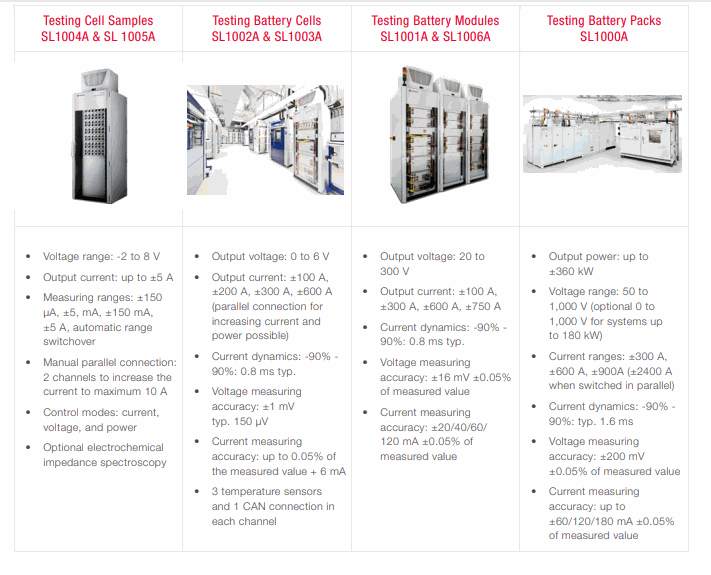
Supporting software
SL1091A Energy Storage Discover
The Scienlab software Energy Storage Discover (ESD) from Keysight allows time-synchronous control of all Scienlab battery test systems for cells, modules, and packs, as well as all test environment components. It permits validation of all energy storage types. The software enables you to easily create, edit, control, and monitor customized test scenarios (Figure 8). The standardized remote interface allows straightforward integration of test benches into a higher-level control and monitoring system.
Battery management system and testing
The introduction of storage technologies and the interconnection of multiple energy storage cells to form modules or packs requires an intelligent BMS.
A BMS assumes important safety, control, and regulation functions. Those functions include monitoring parameters such as voltage, current, temperature, and state of charge. A BMS is also responsible for thermal management, energy management, cell balancing, and performance.
• Voltage: 0 to 8 V
• Current (parallel operation): ±5 A (±10 A)
• Power (parallel operation): ±40 W (±80 W) • Measuring range: up to ±2 µA ± 0.05% of measured value
• Voltage measuring accuracy:
<1mV
The Scienlab BMS Environment also emulates the following:
• Cell temperature through emulation of typical resistance temperature detector (RTD) sensors such as PT-100, PT-500, PT-1000, Ni, and KTY
• Battery current sensors (up to ±1,000 A at a 100 µOhm shunt)
• Individually defined errors such as insulation faults at the battery voltage, line breaks, short-circuits, and reverse polarity
[%end-text-img-same-line%]Charging Technology and Infrastructure Test
One of the crucial factors for the breakthrough of electromobility is making it possible for all drivers to charge their EVs/HEVs conveniently and safely. This puts high demands on the charging interfaces at both sides of the charging cable — on the EVSE and within the vehicle. Alongside the power itself, fault free communication between EV and EVSE guarantees reliable charging. This requires electromagnetic compatibility-compliant components, norm-compliant procedures, and compatible technologies. Other factors to consider include local mains supplies, regional climatic conditions, and compatibility with different EVs and EVSEs.
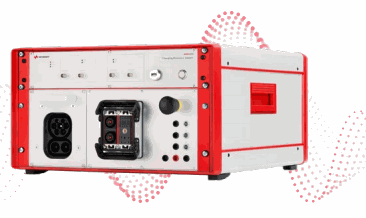
SL1040A Scienlab Charging Discovery System
For comprehensive testing of all EV and EVSE charging interfaces, Keysight offers an all-in-one test solution. The SL1040A Scienlab Charging Discovery System (CDS) series is a breakthrough solution for holistic testing of all AC and DC charging interfaces of EVs and EVSEs. Thanks to its modular and innovative design, the CDS can be configured to customers’ needs to ensure an optimal price-performance ratio (Figure 9). Highlights of CDS include:
• Automated functional, conformance, interoperability, and quality testing for R&D, end of life, and EMC applications
• Time-synchronous measurement and decoding of communication and power signals
• Scalable and future-proof hardware design for all charging protocols and power classes
• Designed according to the CharIN CCS test system specification
• CE and UL conformance certified by CSA
• Broad use by technology-leading EV and EVSE manufacturers, test, and certification bodies
• Conformance test case libraries for immediate testing of CCS, CHAdeMO, and GB/T standards
• Replaces multiple real EV/EVSE with one sophisticated test solution, saving acquisition and running costs
Use case 1: EV test
In this use case, the CDS serves as a universal but configurable charging infrastructure (e.g., DC charging column or AC wall box).
Use it for functional testing of the charging interface of any electric vehicle, as well as for safety, interoperability, conformance, and durability testing.
[%end-text-img-same-line%]Use case 2: EVSE test
Here, the CDS is a universal but configurable charging interface emulator replacing a real electric vehicle.
This allows for functional, safety, interoperability, conformance, and durability testing of any EVSE product.
[%end-text-img-same-line%]Use case 3: Man-in-the-middle test
In this third use case, the CDS sits between two real devices to capture all electrical signals and digital communication between an EVSE and EV.
This allows the user to identify and trace potential interoperability issues.
[%end-text-img-same-line%]Supporting E-Mobility Test Technologies
SL104XA Series Scienlab Dynamic DC Emulator
The Scienlab Dynamic DC Emulator from Keysight boasts bidirectionality, integrated DC voltage and current controllers, high dynamics, and regenerative energy feedback capacity. It serves as an all-in-one system for the efficient and effective testing of power electronic components in EVs and EVSEs. The Dynamic DC Emulator is available for high-voltage and 48 V applications.
Some application examples include:
- Testing of power electronic components and systems for maximum failure safety, energy efficiency, and quality (e.g., traction inverters) .
- Emulation of batteries using an integrated battery model.
- Bidirectional mode testing – enabling EVs to be emulated as a sink or charging infrastructure as a source – to investigate the interoperability of both EVs and EVSEs in combination with the Scienlab Charging Discovery System.
- Validation of DC charging processes
SL106xA Series Scienlab Measurement and Control Modules
Scienlab measurement and control modules from Keysight deliver precise results for a wide range of test, measurement, and control tasks in automotive and industrial product development. They are ideal for carrying out challenging measurement tasks, even under difficult environmental conditions (e.g., in a climate chamber).
Capabilities include:
• Provision of a safe working environment with contact protection up to 1,000 V
• Connection via an open Ethernet interface
• Automatic detection of Scienlab ESD software
• Application to challenging test environments (e.g., -40°C to 80°C, IP20)
[%end-text-img-same-line%]EV1003A power conversion testing for HEV/EV
HEV and full EV batteries are 300 V and higher, versus the conventional 12 V platform used in many vehicles. EV test equipment suitable to handle this new high-voltage, high-power environment is expensive.
Test costs are also escalating. For example, a 10 kW power source consumes 10 times the energy of a 1 kW power source when sourcing full power. This creates a lot of heat, which incurs further cooling costs. You must also comply with high-voltage safety regulations, such as NFPA 79, and provide safety disconnect contingencies. Keysight created the EV1003A Power Converter Test Solution to help you overcome these challenges. The solution comprises three key components:
PA2203 Series IntegraVision Power Analyzer
The IntegraVision Power Analyzer makes EV testing for AC and DC power measurements simple. Easily measure power on any vehicle power converter, such as AC-to-DC power conversion efficiency of the onboard charger:
- Achieve power analyzer accuracies and scope-like waveform visualization with reduced setup time .
- Address multiple test scenarios with the flexibility of wide ranging, isolated inputs .
- Visualize transients, in-rush currents, and state changes with a high-speed digitizer that captures voltage, current, and power in real time
[%end-text-img-same-line%]RP7900 Series Regenerative Power System
The RP7900 Series Regenerative Power System is the core of the solution. It provides battery emulation capabilities for vehicle electrification tests, such as two-quadrant (source/sink) operation and programmable output resistance. It also regenerates greater than 85% of power back to the grid.
[%end-text-img-same-line%]Safety Disconnect System
The SD1000A Safety Disconnect Solution works exclusively with the RP7900 Series. In less than 15 ms, the safety disconnect will remove the output voltage to safeguard your device under test and your people in response to a fault. For testing purposes, the RP7900 can generate faults, or the user can generate them manually. The system complies with key global EMC and safety regulations.
[%end-text-img-same-line%]Energy Ecosystem
PV and smart grid technologies
Supporting the electrification of the modern vehicle is an entire energy ecosystem, from PV inverters that harness and convert solar energy to storage and distribution. Energy efficiency is an integral factor across this ecosystem.
New criteria are emerging to regulate the industry for safety, performance, and business viability. The challenge for engineers is how to verify and test each design, from development to high volume production, to ensure a smooth and safe transition into this brave new world of e-mobility.
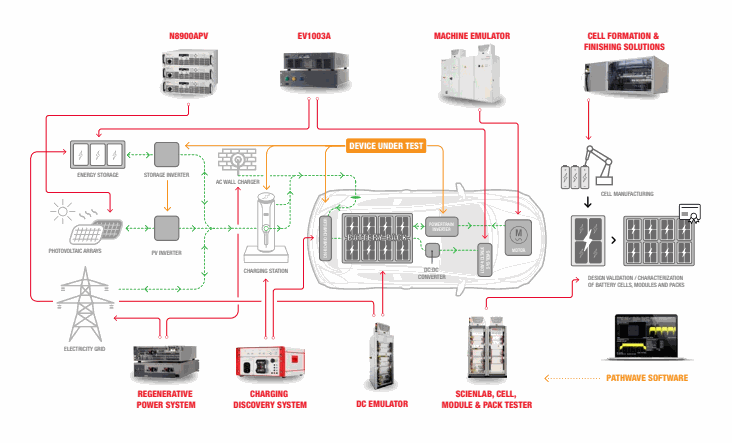
Keysight provides a comprehensive range of solutions to help address your design and test challenges, so you can drive your e-mobility innovations to reality faster. For more information, visit www.keysight.com/find/e-mobility
Agile Design and Test Software
Engineering leaders know that every step in the path to new electronic product development is crucial—from design and simulation to verification and manufacturing. Unfortunately, measurement results from one step don’t seamlessly transition to the next. Test engineers spend hours correlating measurements from their design teams. Software engineers write workarounds because their hardware and software don’t natively talk to each other. Most organizations use standalone products for design, test, measurement, and monitoring. This siloed structure creates disconnected and inefficient workflows and is a major cause of frustration.
Connected, agile design and test is a ground-breaking way to approach the development of electronic systems. It combines new software, new workflows, and powerful automation tools, in a way that transforms legacy processes and yields substantial productivity and equipment utilization improvements. Integrating design and automation software throughout a product development workflow increases efficiency by accelerating routine tasks. Keysight PathWave software is a systems engineering platform that connects design and test, providing common data models and open standards to accelerate product development lifecycles.
Automate, Accelerate, and Scale Your Tests
Perform Analytics for Improved Decision-Making
PathWave offers powerful analytics to help you find, visualize, and understand big data to improve business knowledge. It includes visualization tools, real-time asset monitoring, and advanced algorithms that predict and anticipate anomalies to drive process improvements and increase productivity.
Calibration and repair services
Having the right measurement solution is only the beginning. Design engineers count on repeatable results across work groups to avoid discrepancies that can impact development cycle time, time to market, and budgets.
Our partnership with you
Keysight offers a broad portfolio of services and support to address all your test equipment needs:
• Startup assistance and training help you quickly and effectively use your new equipment
• Calibration and warranty assurance plans provide coverage for five, seven, or 10 years
• Flexible service delivery includes on-site mobile labs that reduce your calibration turnaround time from days to hours
• Premium used equipment includes the same high performance and three-year standard warranty as new units
• Trade-in programs (available on both Keysight and non-Keysight models) offer you significant credits to upgrade to the latest Keysight technology.






